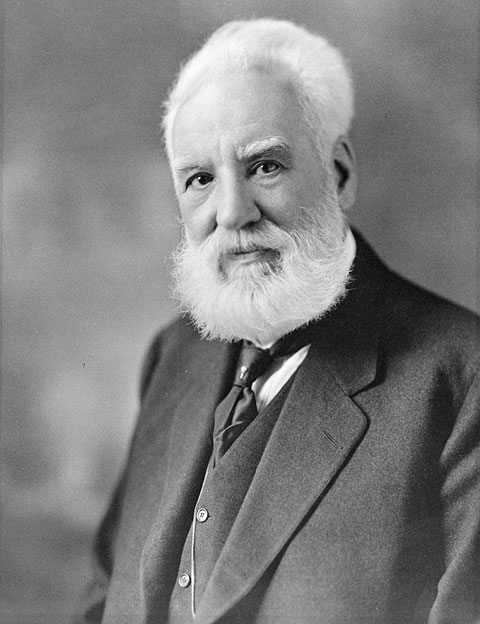Introduction
As low voltage cabling company, and primarily a network cabling company I like to know and understand that technology I work with. I will be writing this article to cover what is inside of the cables that we run through your business, and often that is going to be twisted pair copper cables. We will explore where twisted pair in networking cabling came from, where it is today, and its future.
Early History: Improvements in Telegraphy and the Telephone-Circuit
The history of twisted pair begins with Alexander Graham Bell, and his followup to the creating the telephone, twisting two wires together.
In 1876 he invented the telephone with his patent called “Improvements in Telegraphy,” severely underselling the fact these “improvements” included being able to transmit voice back and forth at the same time. And then in 1881 he patented the “Telephone Circuit” again underselling the fact this patent didn’t create the telephone circuit, he did that with the first one, but improved the bi-directional signaling by twisting cables.
Writing in his patent that you could simply run two cables really close together and get a signal improvement, but if you twisted them, you would get “the most perfect freedom from inductive disturbance.” We now call this inductive disturbance “electrical interference.”
While twisted was preferred, it may have been less structurally sound than parallel wires, which makes sense when you consider that the wires were wrapped in cotton or silk soaked in paraffin wax—not as tough an insulator as our modern rubber cables.


Early telephone sketch hand drawn by Alexander Graham Bell
The Rise of Twisted Pair in Networking
It would be 90 years before early tests with twisted pair for computer networking began, and more than 100 years before it was adopted as a commercial standard. In that time, the world saw two world wars, the invention of flight, the moon landing, and the rise of electronic computing. But not much happened with twisted pair. There were some incremental improvements—shielded twisted pair was introduced, early standardization efforts took place, and insulation materials improved—but it remained largely a telephone technology until networking came along.
Fast forward to 1973, and twisted pair makes another appearance—this time in the hands of researchers at Xerox’s Palo Alto Research Center (PARC). Robert Metcalfe and David Boggs were developing what would become Ethernet, an experimental local area network that let computers talk to each other at high speeds. Their first Ethernet design ran over coaxial cable called 10BASE-5, or “thicknet,” but they tested twisted pair early on.
Thicknet would eventually evolve into 10BASE-2, or Thinnet, a much more manageable cable, but it still had some of the same issues as Thicknet, which we will cover in another article/video. It was these evolving standards and the foundational work occurring at Xerox PARC that would eventually bring us back to twisted pair, which promised to alleviate some of the issues related to signal integrity, especially over longer distances.
Standardization and the Evolution of Twisted Pair
By the beginning of the 1980s, twisted pair looked like it could succeed coaxial cabling in networking. In 1983, an experimental version of twisted pair was designed by AT&T for their StarLAN cables, an early 1 Mbps networking solution that would later be adopted by the IEEE (Institute of Electrical and Electronics Engineers) in their 802.3e format in 1986. While StarLAN wasn’t a widespread standard, it was the first networking system built specifically for twisted pair, providing a baseline for what came next.
StarLAN used two or four pairs of cables, a layout that would soon standardize at four pairs in the next generation. This shift established a foundation for 10BASE-T, the first widely adopted Ethernet standard for twisted pair, which debuted in 1990 as part of IEEE 802.3i.

And this is where we smooth out into the modern era. Networking companies are no longer looking at competing proprietary standards but generational Category (Cat) standards. Instead of choosing between entirely different physical mediums, twisted pair was evolving into rated categories with stricter performance requirements.
For example:
• Cat 1 was used for voice calls. That’s it. Just phone lines.
• Cat 2 had some data applications, but it was mostly a glorified phone line.
• Cat 3 was the first real networking cable standard, the go-to for 10BASE-T Ethernet.
• Cat 4, Cat 5, and beyond started ramping up speed and reliability, taking Ethernet from 10 Mbps to 100 Mbps (Fast Ethernet), 1 Gbps (Gigabit Ethernet), and beyond.
What I found most surprising researching this video, as someone who has worked in IT at medium and large businesses for over a decade, was how old some of the Cat standards are compared to when I saw them start to become adopted and standardized in my workplaces.
Modern Usage and future of twisted pair
Cat 5 and Cat 5e were standardized in ’95 and 2001 respectively, with Cat 6 and Cat 6a being standardized in 2002 and 2008 respectively. I was working on a large new build at a previous job from 2015 through 2018, and we were still running a standard of Cat 5e. My most recent work has seen a migration, finally, to Cat 6a—a cool 14 years after standardization.
A lot of this doesn’t have much to do with the cables themselves and what they are capable of, but everything else in a business’s network stack. Your network is only as fast as the slowest leg, and Cat 5e just so happened to be fast enough for most installations for nearly two decades—which, in technical fields, might as well be another century.
Conclusion: The Future Beyond Twisted Pair
Which brings us to the end, where we currently are, with Cat 8 being the most recent standard, from 2016. These cables are capable of mind-blowing speeds of 25 Gbps or 40 Gbps depending on the equipment they are plugged into. However, these cables have significantly shorter run distances than the typical Cat cables, only approximately 100 ft (30 meters), which allows them to exist only in niche scenarios for most businesses.
It may be possible that we are at the end of the road with improvements in this standard. Twisted pair cabling, for all its advancements over the decades, is still bound by the fundamental limitations of copper as a transmission medium.
Where do we go from here? For speeds beyond 10 Gbps and for longer runs, fiber optics is taking over—if it hasn’t already.
Article written by:
Kevin Simmons
Owner / Operator of Hermes Cabling
Sources:

